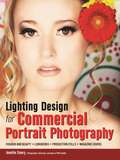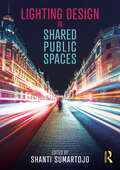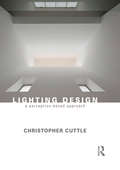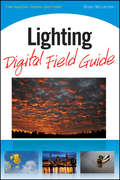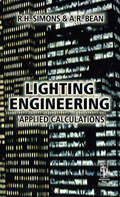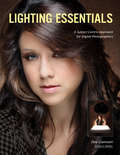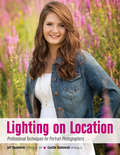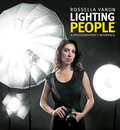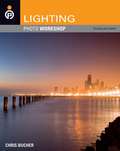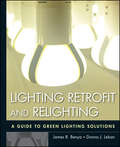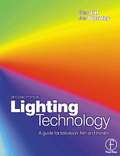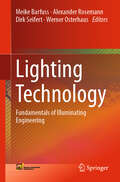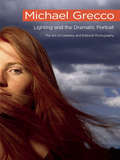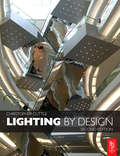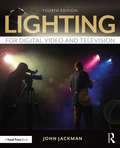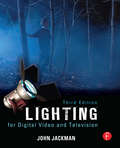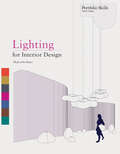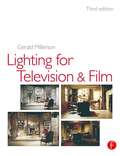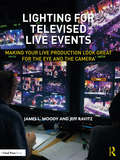- Table View
- List View
Lighting Design for Commercial Portrait Photography
by Jennifer EmeryEffective commercial portraiture is heavily reliant on clean, crisp lighting looks that emphasize color, contrast, contours, and texture to allow viewers of magazines, newspapers, television, and movies to view a product or model/celebrity in a precise and predetermined way that suits the overall marketing campaign and leaves viewers with a specific, conscripted feeling about the product /person being shown. Crafting this type of polished lighting requires absolute proficiency with the tools of the trade, from flash, to beauty lights, to softboxes, to gobos and gels. It also requires thinking outside the box to create lighting with a "hook”--a certain quality that binds the look to the brand identity and can be carried out repeatedly across several advertising campaigns. Whether you are producing album cover art, lingerie shoots for an intimates catalog, or production stills for television shows or movies, Jennifer Emery will give you the technical and creative skill set you need to thrive artistically, work efficiently with models and set designers, and win repeat clients. Beginning with essential strategies for finding and casting talent, paying/trading with that talent, and creating an open dialogue throughout the directorial stages, Jennifer builds a solid foundation from which the artistic concept can spring forth. In the following chapters, she presents text and images that will instruct readers on creating numerous looks/projects, including: (1) Beauty lighting for beauty/cosmetics ads (2) High-Key Lighting for a magazine cover shoot, (3) Lighting groups for a movie/TV poster, (4) Sculpting light for boudoir/lingerie/swimsuit/nude photograph, (5) Working with speedlights/flash for editorial fashion and lifestyle shoots, and (6) Lighting exterior locations for high fashion and fashion editorial work. Armed with these skills, photographers will be able to approach any commercial lighting job with a repertoire of skills, an ability to overcome challenges, and the confidence needed to nail the shot every time.
Lighting Design in Shared Public Spaces
by Shanti SumartojoThis book advocates an approach to lighting design that focuses on how people experience illumination. Lighting Design in Shared Public Spaces contextualises light, dark and lighting design within the settings, sensations, ideas and imaginaries that form our understandings of ourselves and the world around us. The chapters in this collection bring a new perspective to lighting design, arguing for an approach that addresses how lighting is experienced, understood and valued by people. Across a range of new case studies from Australia, Germany, Denmark, and the United Kingdom, the authors account for lighting design’s crucial role in shaping our dynamic and messy experiential worlds. With many turning to innovative ethnographic methodologies, they powerfully demonstrate how feelings of comfort, safety, security, vulnerability, care and well-being can configure in and through how people experience and manipulate light and dark. By focusing on how lighting is improvised, arranged, avoided and composed in relation to the people and things it acts upon, the book advances understandings of lighting design by showing how improved experiences of the built environment can result from more sensitive and context-specific illumination. The book is intended for social scientists who are interested in the lit or sensory world, as well as designers, architects, urban planners and others concerned with how the experience of light, dark and lighting might be both better understood and implemented in our shared public spaces.
Lighting Design: A Perception-Based Approach
by Christopher CuttleBy reading this book, you will develop the skills to perceive a space and its contents in light, and be able to devise a layout of luminaires that will provide that lit appearance. Written by renowned lighting expert Christopher (Kit) Cuttle, the book: explains the difference between vision and perception, which is the distinction between providing lighting to make things visible, and providing it to influence the appearance of everything that is visible; demonstrates how lighting patterns generated by three-dimensional objects interacting with directional lighting are strongly influential upon how the visual perception process enables us to recognize object attributes, such as lightness, colourfulness, texture and gloss; reveals how a designer who understands the role of these lighting patterns in the perceptual process may employ them either to reveal, or to subdue, or to enhance the appearance of selected object attributes by creating appropriate spatial distributions of light; carefully explains calculational techniques and provides easy-to-use spreadsheets, so that layouts of lamps and luminaires are derived that can be relied upon to achieve the required illumination distributions. Practical lighting design involves devising three-dimensional light fields that create luminous hierarchies related to the visual significance of each element within a scene. By providing you with everything you need to develop a design concept - from the understanding of how lighting influences human perceptions of surroundings, through to engineering efficient and effective lighting solutions – Kit Cuttle instills in his readers a new-found confidence in lighting design.
Lighting Digital Field Guide
by Brian MclernonEssential lighting guide for users of compact cameras and dSLRsOne of the most important aspects of photography is lighting, but getting the lighting right is tricky. When should you use flash? Are a camera's automatic settings dependable? Should you use reflectors or diffusers and where do you place them? This handy, portable reference will show you when, where, and how to create and capture perfect light, every time. The book includes a color checker card to help you maintain true color, as well as examples of stunningly-lit photos of people, wildlife, and landscapes to inspire you.Walks you through the essentials of lighting for digital photographyHelps beginning and intermediate photographers leave the safety of automatic settings and confidently control lighting themselvesShows how to evaluate natural light, decide when to use flash, and how and when to use diffusers or reflectorsIncludes a tear-out color checker card to help you maintain true color in your photographsComes in the handy, portable Digital Field Guides size, perfect for camera bagsCreate and capture the perfect lighting every time, with Lighting Digital Field Guide!
Lighting Engineering: Applied Calculations
by R. H. Simons A.R. Bean'Lighting Engineering: Applied Calculations' describes the mathematical background to the calculation techniques used in lighting engineering and links them to the applications with which they are used. The fundamentals of flux and illuminance, colour, measurement and optical design are covered in detail. There are detailed discussions of specific applications, including interior lighting, road lighting, tunnel lighting, floodlighting and emergency lighting. The authors have used their years of experience to provide guidance for common mistakes and useful techniques including worked examples and case studies.The last decade has seen the universal application of personal computers to lighting engineering on a day-to-day basis. Many calculations that were previously impracticable are therefore now easily accessible to any engineer or designer who has access to an appropriate computer program. However, a grasp of the underlying calculation principles is still necessary in order to utilise these technologies to the full. Written by two of the leading authorities on this subject, 'Lighting Engineering' is essential reading for practising lighting engineers, designers and architects, and students in the field of lighting.
Lighting Essentials
by Don GiannattiEncouraging photographers to take a subject-oriented approach to lighting, this manual shows it is possible to make better decisions about both the technical and artistic aspects of lighting. It teaches how to identify qualities the subject possesses that the light will react with and how to use this knowledge to create perfect photographs. Through a variety of amply illustrated shoots, the book explains how to approach each image from the perspective of controlling the subject’s appearance to match the photographer’s vision for the picture. This comprehensive guide covers such topics as the benefits and drawbacks of various lighting tools, the effect of light placement, and controlling lighting ratios. Designed for intermediate-to-advanced photographers, it illustrates techniques for using light as a tool to capture the subject in the best possible manner.
Lighting Essentials
by Don GiannattiEncouraging photographers to take a subject-oriented approach to lighting, this manual shows it is possible to make better decisions about both the technical and artistic aspects of lighting. It teaches how to identify qualities the subject possesses that the light will react with and how to use this knowledge to create perfect photographs. Through a variety of amply illustrated shoots, the book explains how to approach each image from the perspective of controlling the subject's appearance to match the photographer's vision for the picture. This comprehensive guide covers such topics as the benefits and drawbacks of various lighting tools, the effect of light placement, and controlling lighting ratios. Designed for intermediate-to-advanced photographers, it illustrates techniques for using light as a tool to capture the subject in the best possible manner.
Lighting Essentials
by Don GiannattiEncouraging photographers to take a subject-oriented approach to lighting, this manual shows it is possible to make better decisions about both the technical and artistic aspects of lighting. It teaches how to identify qualities the subject possesses that the light will react with and how to use this knowledge to create perfect photographs. Through a variety of amply illustrated shoots, the book explains how to approach each image from the perspective of controlling the subject’s appearance to match the photographer’s vision for the picture. This comprehensive guide covers such topics as the benefits and drawbacks of various lighting tools, the effect of light placement, and controlling lighting ratios. Designed for intermediate-to-advanced photographers, it illustrates techniques for using light as a tool to capture the subject in the best possible manner.
Lighting Essentials
by Don GiannattiEncouraging photographers to take a subject-oriented approach to lighting, this manual shows it is possible to make better decisions about both the technical and artistic aspects of lighting. It teaches how to identify qualities the subject possesses that the light will react with and how to use this knowledge to create perfect photographs. Through a variety of amply illustrated shoots, the book explains how to approach each image from the perspective of controlling the subject's appearance to match the photographer's vision for the picture. This comprehensive guide covers such topics as the benefits and drawbacks of various lighting tools, the effect of light placement, and controlling lighting ratios. Designed for intermediate-to-advanced photographers, it illustrates techniques for using light as a tool to capture the subject in the best possible manner.
Lighting On Location: Professional Techniques For Portrait Photographers
by Jeff Dachowski Carolle DachowskiLocation portraiture offers many advantages. The backgrounds are varied, the surroundings can tell a story about the client, and the setting can help tell the subject’s story. Working on location presents unique challenges, however. Often, the photographer is working in an unfamiliar place in which the lighting is not ideal for portraiture. Light is the very backbone of a good portrait, so the need to manage and modify the light becomes a top priority in the portrait session. The Dachowskis teach you how to harness the light in any scenario--from direct sun, to window light, to fluorescent light, to household lamp light, and even mixed-lighting scenarios--to create correct exposures and believable image color. You’ll learn to restrict and enhance the light, add dramatic highlights and shadows to create dimension, and set the mood in the portrait. With these tips, you’ll learn to handle location portrait challenges with ease and confidence.
Lighting People: A Photographer's Reference
by Rossella VanonA COMPLETE PHOTOGRAPHER'S TECHNIQUES, POSING GUIDE & REFERENCELighting People is an art every photographer - and every photography student - must master, and this single volume is both a complete course and the most useful reference book you can find. SECTION 1: UNDERSTANDING LIGHTChapter 1: Lighting Equipment - Get to grips with light every artificial light-source: Continuous Light, Flash, Studio Strobes & Speedlights, as well as modifiers. Chapter 2: Setting The Mood - Understand the effect you can have with your lighting; hard & soft, low & high key, bounce, feathering, fall-off and more.Chapter 3: Standard Lighting Techniques - How to pull off techniques including: Loop, Rembrandt, Butterfly, Split, Clamshell and Accent.Chapter 4: Camera Settings - Using your camera's exposure settings to get the best from any lighting equipment.SECTION 2: WORKING WITH LIGHTChapter 5: Preparation - How to evaluate your client and their brief and plan a shoot.Chapter 6: Lighting Scenarios - Tips and tricks for doing the best whether you're shooting portraits, fashion, beauty, events or more.Chapter 7: Getting Started - Choosing your lights and setting up your shoot.Chapter 8: Getting Creative - Use gels, projections, blur and other effects for more unusual images.SECTION 3: RESOURCESLighting Setups: Hands-on examples of studio shootsLighting Reference Gallery: Hundreds featuring the same four models lit against a white and a dark background from a number of different angles; the most complete lighting reference available.
Lighting Photo Workshop
by Chris BucherA rigorous practical guide to photographic lighting techniques, complete with hands-on assignments Offering digital photographers a complete course in photographic lighting, this book covers everything from using flash systems and studio lights to working outdoors in bright or low-light conditions. Full-color examples show how the right lighting can enhance color, improve contrast, and open the door to new creative possibilities.
Lighting Retrofit and Relighting
by James R. Benya Donna J. Leban Willard L. WarrenThe ultimate guide to the retrofitting of lighting for greater efficiency and performance Retrofitting outdated energy-guzzling lighting components with green energy-saving alternatives is a process that promotes sustainability and offers significant benefits for businesses, contractors, and the community at large. Not only can retrofitting improve the overall quality and functionality of light, it also can make spaces safer, easier and less costly to maintain, and more comfortable to inhabit. From lighting technology to retrofit financial analysis, Lighting Retrofit and Relighting evaluates the latest lighting system types, then demonstrates how to apply them for the greatest functional and cost-saving benefit. This book: Discusses the recent advances in lighting equipment and retrofittable controls, for both interior and outdoor use Explains how to do a lighting audit to identify and evaluate logical retrofit choices Includes case studies of retrofits, illustrating improvements in the quality and efficacy of new lighting Demonstrates how cost savings realized over time can not only pay for new equipment but produce a return on the investment Lighting Retrofit and Relighting serves as an ideal reference for students or professionals-whether they are energy auditors, designers, installers, facilities managers, or manufacturers-by taking a close look at the most current lighting technology illuminating pathways toward a brighter future.
Lighting Technology: A Guide For The Entertainment Industry
by Brian Fitt Joe ThornleyAnyone working with lighting in the entertainment industries will find this an immensely readable source of information. The authors, themselves experienced lighting practitioners, have collected a wealth of essential lighting technology and data into one comprehensive reference volume in an accessible, jargon-free style. The new edition of this popular text covers the very latest technology, including advances in lamps, motorised lights, dimmers and control systems and current safety regulations.
Lighting Technology: Fundamentals of Illuminating Engineering
by Alexander Rosemann Dirk Seifert Meike Barfuss Werner OsterhausLighting Technology offers a comprehensive and complete overview on the field. It is a translation of the 5th edition of the German textbook "Beleuchtungstechnik" by Huss Media, Berlin. It introduces the fundamentals of lighting technology and discusses concepts for good lighting and daylighting design. This book is widely used in German universities and has already helped generations of students to graduate and kick-off their professional career in the field of lighting. Valuable contributions to this book came from a group of well-established lighting experts consisting of academics and design professionals. It covers the following key aspects: Fundamentals of Lighting Technology, Light Sources and Auxiliary Devices, Luminaires, Lighting Control, Illumination with Daylight, Illumination Systems for Interior Spaces, and Illumination Systems for Exterior Spaces. The motivation for this book was initiated in National lighting associations including but not limited to the German LiTG, the Dutch NSVV andthe Intelligent Lighting Institute ILI of Eindhoven University of Technology with the goal to transfer expert knowledge to everybody interested in broadening his knowledge in the field of lighting technology and illuminating engineering, like university students, researchers and lighting designers. It is suitable to serve as a supportive source of knowledge and reference when studying lighting technology or pursuing a professional qualification as ELE (European Lighting Expert) offered by ELEA, the European Lighting Expert Association. The book provides all the knowledge necessary for working on and successfully completing innovative lighting projects.
Lighting and the Dramatic Portrait: The Art of Celebrity and Editorial Photography
by Michael GreccoRenowned celebrity photographer Michael Grecco's seminal bestselling book "Lighting and the Dramatic Portrait: The Art of Celebrity and Editorial Photography" is a photographers "lighting "bible". A must-have for portrait photographers, Grecco reveals step-by-step every aspect of his craft including exact diagrams for perfect lighting while inspiring the true art of the portrait. You'll learn exactly why "Time," "People," and "Business Week" and celebrities such as Chris Rock, Salma Hayek, Kate Winslet, and Lucy Liu all trust Michael Grecco to shoot their coveted celebrity covers.Grecco's beautiful, insightful work is all around us--on movie posters, in advertising, on magazine covers, everywhere. "I delight in inspiring people," he writes. "I want them to stop, think, and feel." Now Grecco shares the secrets of great portraits with photographers at every level, in "Lighting and the Dramatic Portrait." Sections on cameras, illumination, film and digital, creativity and conceptualization, connecting with the subject, and having a point of view, plus intriguing case studies that show "how I got that picture," make this book a resource photographers will use again and again through the years. Whether the subject is a star or a soccer mom, Grecco shows how to add artistry, drama, wit, humor, and personality to their portrait.
Lighting by Design
by Christopher CuttleLighting by Design provides guidance on where to find inspiration for lighting ideas, how to plan the technical detail and how to execute the plan to create safe, effective and beautiful schemes. Christopher Cuttle's unique three level approach uses Observation, Visualisation and Realisation as the means to achieve these aims. Cuttle is a well known figure in the UK, US and Australia and New Zealand, with a wealth of experience of both teaching and practice. This new edition is fully updated and produced in full colour with many new diagrams and photographs. It will be immensely useful to professional and student architects, interior designers and specialist lighting designers.
Lighting for Animation: The Art of Visual Storytelling
by Jasmine Katatikarn Michael TanzilloLighting for Animation is designed with one goal in mind - to make you a better artist. Over the course of the book, Jasmine Katatikarn and Michael Tanzillo (Senior Lighting TDs, Blue Sky Studios) will train your eye to analyze your work more critically, and teach you approaches and techniques to improve your craft. Focusing on the main philosophies and core concepts utilized by industry professionals, this book builds the foundation for a successful career as a lighting artist in visual effects and computer animation. Inside you’ll find in-depth instruction on: • Creating mood and storytelling through lighting • Using light to create visual shaping • Directing the viewer’s eye with light and color • Gathering and utilizing reference images • Successfully lighting and rendering workflows • Render layers and how they can be used most effectively • Specific lighting scenarios, including character lighting, environment lighting, and lighting an animated sequence • Material properties and their work with lighting • Compositing techniques essential for a lighter • A guide on how to start your career and achieve success as a lighting artist This book is not designed to teach software packages—there are websites, instructional manuals, online demos, and traditional courses available to teach you how to operate specific computer programs. That type of training will teach you how to create an image; this book will teach you the technical skills you need to make that image beautiful. Key Features Stunning examples from a variety of films serve to inspire and inform your creative choices. Unique approach focuses on using lighting as a storytelling tool, rather than just telling you which buttons to press. Comprehensive companion website contains lighting exercises, assets, challenges, and further resources to help you expand your skillset.
Lighting for Cinematography: A Practical Guide to the Art and Craft of Lighting for the Moving Image (The CineTech Guides to the Film Crafts)
by David LandauWe can't shoot good pictures without good lighting, no matter how good the newest cameras are. Shooting under available light gives exposure, but lacks depth, contrast, contour, atmosphere and often separation. The story could be the greatest in the world, but if the lighting is poor viewers will assume it's amateurish and not take it seriously. Feature films and TV shows, commercials and industrial videos, reality TV and documentaries, even event and wedding videos tell stories. Good lighting can make them look real, while real lighting often makes them look fake. Lighting for Cinematography, the first volume in the new CineTech Guides to the Film Crafts series, is the indispensable guide for film and video lighting. Written by veteran gaffer and cinematographer David Landau, the book helps the reader create lighting that supports the emotional moment of the scene, contributes to the atmosphere of the story and augments an artistic style. Structured to mimic a 14 week semester, the chapters cover such things as lighting for movement, working with windows, night lighting, lighting the three plains of action and non-fiction lighting. Every chapter includes stills, lighting diagrams and key advice from professionals in the field, as well as lighting exercises to help the reader put into practice what was covered.
Lighting for Digital Video and Television
by John JackmanThis book gives a comprehensive overview of lighting equipment and techniques for digital production. Suitable for either beginners or more advanced users, the fully updated fourth edition covers human sight vs. film or video, the basic issues of contrast and exposure, with explanation of how exposure of digital video differs from analog video or film, electrical connectors, requirements, electrical load management, safety issues, and the latest LED systems.A variety of basic lighting setups for different situations are explained, with clear diagrams and photos showing the "look" of each approach. Techniques for shooting in available light and dealing with color problems in mixed lighting situations is examined. More advanced film-style lighting is covered, especially techniques in creating a convincing realistic look. A special section deals with solutions to common problems, ranging from reflections on glasses and dealing with white walls, to lighting very light-skinned and very dark-skinned subjects in the same shot. Special lighting situations, such as lighting night scenes or bluescreen sets, are covered in detail, with studio lighting covered in a dedicated separate chapter. The book is also peppered with anecdotes and trivia about lighting techniques and the lighting trade. It is the ideal text for both beginners studying lighting and cinematography, as well as more advanced practitioners.
Lighting for Digital Video and Television (Dv Expert Ser.)
by John JackmanEnhance the visual quality of your motion pictures and digital videos with a solid understanding of lighting fundamentals. This complete course in digital video lighting begins with how the human eye and the camera process light and color, progresses through the basics of equipment and setups, and finishes with practical lessons on how to solve common problems. Filled with clear illustrations and real-world examples that demonstrate proper equipment use, safety issues, and staging techniques, Lighting for Digital Video presents readers with all they need to create their own visual masterpieces. Features * film style techniques for digital video productions * creating "movie" looks on a low budget * lighting for HD * how to maximize existing light * how to be a grip + safety issues * interview setups * color correction techniques in mixed lighting situations
Lighting for Interior Design (Portfolio Skills Ser.)
by Malcolm InnesWithout light, interior architecture cannot be fully designed and experienced. It is one of the key tools for an interior designer, but can be a dauntingly technical subject for students.Part One, Theory, looks at the physics and technology behind lighting. Part Two, Process and Practice, looks more specifically at the use of lighting in interior design and outlines the key design issues and principles. The book goes on to show the ways of representing lighting schemes using CAD and 3D models and how to implement and test these designs. Finally, the book explains how to deal with contractors, clients and other professionals.This book takes a detailed, practical look at lighting in interior design, giving students all the key information and skills they need to be able to tackle lighting successfully in their designs.
Lighting for Interior Design (Portfolio Skills)
by Malcolm InnesWithout light, interior architecture cannot be fully designed and experienced. It is one of the key tools for an interior designer, but can be a dauntingly technical subject for students.Part One, Theory, looks at the physics and technology behind lighting. Part Two, Process and Practice, looks more specifically at the use of lighting in interior design and outlines the key design issues and principles. The book goes on to show the ways of representing lighting schemes using CAD and 3D models and how to implement and test these designs. Finally, the book explains how to deal with contractors, clients and other professionals.This book takes a detailed, practical look at lighting in interior design, giving students all the key information and skills they need to be able to tackle lighting successfully in their designs.
Lighting for TV and Film (Library Of Communication Techniques Ser.)
by Gerald MillersonSkilful lighting involves a subtle blend of systematic mechanics and a sensitive visual imagination. It requires anticipation, perceptiveness, patience and know-how. But learning through practice alone can take a great deal of time. This book is a distillation of many years' experience, with advice and guidance that will bring successful results right from the start. Whether you are a student studying lighting techniques in the television, video and film media, or a professional lighting for the camera, this book will be an invaluable aid. Other members of the production team, including camera crews, designers and directors, will also find the information here interesting and useful.The book concentrates primarily on the fundamental principles of lighting in studios, on location and display, as well as single-camera, small unit production, improvised and economy lighting, and working with limited facilities. Emphasis is also placed on the safety aspects of working with lighting equipment.Lighting for Television and Film reflects the author's considerable experience of lighting techniques in BBC studios, his teaching and consultancy work.Gerald Millerson's analytical writings spring from a lifetime's personal experience in the medium, and from his teaching and engineering background. During his career with the BBC, he was primarily associated with studio operations in the Television Service. His lecturing background included courses in TV production at a number of American universities.His other books for Focal Press are Television Production, TV Scenic Design, Video Production Handbook and, in the Media Manuals series, Effective TV Production, Lighting for Video and Video Camera Techniques.
Lighting for Televised Live Events: Making Your Live Production Look Great for the Eye and the Camera
by James L. Moody Jeff RavitzLighting for Televised Live Events unlocks the science, art, philosophies, and language of creating lighting for live entertainment and presentations that work for the television camera as well as for the live audience. The book explores how to retain the essence and excitement of a live production while assuring that the show looks its best on-camera for the millions of viewers that can only see it on their TV, computer, tablet, or mobile phone screen. Readers will learn how to adapt an existing stage show for the camera, as well as how to design live entertainment or events specifically for TV. Filled with real-life examples and illustrations, the book covers a wide range of topics, including: how exposure and color work for the camera; how angle, visual balance, and composition can make people and backgrounds look their best, while preserving theatricality; information on camera equipment, screens, and projectors, as well as the control room environments that are found on a professional shoot; the unique challenges of lighting for the IMAG video screens used at festivals and concerts. Lighting for Televised Live Events is aimed at lighting design students, as well as professional designers that are considering a career — or a career expansion — in television. It is an essential resource for any stage lighting designer whose show may be shot for a television special or a live webcast and who will be asked by their client to collaborate with the incoming video team.
